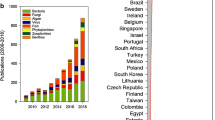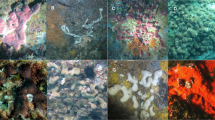Abstract
To investigate the prokaryotic community structure and composition in an active hydrothermal site, named Black Point, off Panarea Island (Eolian Islands, Italy), we examined sediment and fluid samples, differing in temperature, by a massive parallel sequencing (Illumina) technique targeting the V3 region of the 16S rRNA gene. The used technique enabled us to detect a greater prokaryotic diversity than that until now observed and to reveal also microorganisms occurring at very low abundance (≤0.01 %). Most of sequences were assigned to Bacteria while Archaea were a minor component of the microbial community in both low- and high-temperature samples. Proteobacteria (mainly consisting of Alpha-, Gamma-, and Epsilonproteobacteria) dominated among all samples followed by Actinobacteria and Bacteroidetes. Analyzed DNA obtained from samples taken at different temperatures indicated the presence of members of different dominant genera. The main differences were observed between sediment samples where Rhodovulum and Thiohalospira prevailed at high temperature, while Thalassomonas and Sulfurimonas at low temperature. Chlorobium, Acinetobacter, Sulfurimonas, and Brevundimonas were abundant in both low- and high-temperature fluid samples. Euryarchaeota dominated the archaeal community in all samples. Classes of Euryarchaeota embracing hyperthermophilic members (Thermococci and Thermoplasmata) and of Crenarchaeota (Thermoprotei) were more abundant in high-temperature samples. A great number of sequences referred to Bacteria and Archaea still remained unaffiliated, indicating that Black Point site represents a rich source of so-far uncharted prokaryotic diversity.


Similar content being viewed by others
References
Alain K, Zbinden M, Bris NL, Lesongeur F, Quérellou J, Gaill F, Cambon-Bonavita MA (2004) Early steps in microbial colonization processes at deep-sea hydrothermal vents. Environ Microbiol 6:227–241
Amend JP, Meyer-Dombard DR, Sheth SN, Zolotova N, Amend AC (2003) Palaeococcus helgesonii sp. nov., a facultatively anaerobic, hyperthermophilic archaeon from a geothermal well on Vulcano Island, Italy. Arch Microbiol 179:394–401
Barns SM, Cain EC, Sommerville L, Kuske CR (2007) Acidobacteria phylum sequences in uranium-contaminated subsurface sediments greatly expand the known diversity within the phylum. Appl Environ Microbiol 73:3113–3116
Bartram AK, Lynch MDJ, Stearns JC, Moreno-Hagelsieb G, Neufeld JD (2011) Generation of multimillion-sequence 16S rRNA gene libraries from complex microbial communities by assembling paired-end Illumina reads. Appl Environ Microbiol 77:3846–3852
Campbell BJ, Engel AS, Porter ML, Takai K (2006) The versatile epsilon-Proteobacteria: key players in sulphidic habitats. Nat Rev Microbiol 4:458–468
Cole JR, Wang Q, Cardenas E, Fish J, Chai B, Farris RJ, Kulam-Syed-Mohideen AS, McGarrell DM, Marsh T et al (2009) The Ribosomal Database Project: improved alignments and new tools for rRNA analysis. Nucleic Acids Res 37:D141–D145
Danovaro R, Corinaldesi C, Luna GM, Magagnini M, Manini E, Pusceddu A (2009) Prokaryote diversity and viral production in deep-sea sediments and seamounts. Deep Sea Res II 56:738–747
DasSarma S, Fleischmann EF (1995) Archaea: a laboratory manual—halophiles. Cold Spring Harbour Laboratory Press, New York, pp 269–272
DeLong EF (2003) Oceans of Archaea. ASM News 69:503–511
Edgar RC (2010) Search and clustering orders of magnitude faster than BLAST. Bioinformatics. doi:10.1093/bioinformatics/btq461
Fiala G, Stetter KO, Jannasch HW, Langworthy TA, Madon J (1986) Staphylothermus marinus sp. nov., represents a novel genus of extremely thermophilic submarine heterotrophic archaebacteria growing up to 98°C. Syst Appl Microbiol 8:106–113
Flores GE, Shakya M, Meneghin J, Yang ZK, Seewald JS, Geoff Wheat C, Podar M, Reysenbach AL (2012) Inter-field variability in the microbial communities of hydrothermal vent deposits from a back-arc basin. Geobiology 10:333–346
Giovannelli D, d’Errico G, Manini E, Yakimov M, Vetriani C (2013) Diversity and phylogenetic analyses of bacteria from a shallow-water hydrothermal vent in Milos island (Greece). Front Microbiol. doi:10.3389/fmicb.2013.00184
Gloor GB, Hummelen R, Macklaim JM, Dickson RJ, Fernandes AD, MacPhee R, Reid G (2010) Microbiome profiling by Illumina sequencing of combinatorial sequence-tagged PCR products. PLoS ONE 5:e15406
Gugliandolo C, Italiano F, Maugeri TL, Inguaggiato S, Caccamo D, Amend JP (1999) Submarine hydrothermal vents of the Eolian Islands: relationship between microbial communities and thermal fluids. Geomicrobiol J 16:105–117
Gugliandolo C, Italiano F, Maugeri TL (2006) The submarine hydrothermal system of Panarea (Southern Italy): biogeochemical processes at the thermal fluids-sea bottom interface. Ann Geophys 49:783–792
Gugliandolo C, Lentini V, Spanò A, Maugeri TL (2012) New bacilli from shallow hydrothermal vents of Panarea Island (Italy) and their biotechnological potentialities. J Appl Microbiol 112:1102–1112
Hamel M (2010) Investigation and modeling of the geochemical processes in the hydrothermal system of Panarea, Italy. FOG—Freiberg Online Geoscience 25:1–115
Hansen MC, Tolker-Neilson T, Givskov M, Molin S (1998) Biased 16S rDNA PCR amplification caused by interference from DNA flanking template region. FEMS Microbiol Ecol 26:141–149
Hirayama H, Sunamura M, Takai K, Nunoura T, Noguchi T, Oida H, Furushima Y, Yamamoto H et al (2007) Culture-dependent and -independent characterization of microbial communities associated with a shallow submarine hydrothermal system occurring within a Coral Reef off Taketomi Island, Japan. Appl Environ Microbiol 73:7642–7656
Huber JA, Butterfield DA, Baross JA (2003) Bacterial diversity in a subsea floor habitat following a deep-sea volcanic eruption. FEMS Microbiol Ecol 43:393–409
Huse SM, Dethlefsen L, Huber JA, Welch DM, Relman DA, Sogin ML (2008) Exploring microbial diversity and taxonomy using SSU rRNA hypervariable tag sequencing. PLoS Genet 4:1–10
Inagaki F, Takai K, Kobayashi H, Nealson KH, Horikoshi K (2003) Sulfurimonas autotrophica gen. nov., sp. nov., a novel sulfur-oxidizing epsilon-proteobacterium isolated from hydrothermal sediments in the Mid-Okinawa Trough. Int J Syst Evol Microbiol 53:1801–1805
Italiano F (2009) Hydrothermal fluids vented at shallow depths at the Aeolian islands: relationships with volcanic and geothermal systems. FOG—Freiberg Online Geoscience 22:55–60
Italiano F, Nuccio PM (1991) Geochemical investigations of submarine volcanic exhalations to the East of Panarea, Eolian Islands, Italy. J Volcanol Geotherm Res 46:125–141
Lentini V, Gugliandolo C, Maugeri TL (2007) Identification of enzyme-producing thermophilic bacilli isolated from marine vents of Aeolian Islands (Italy). Ann Microbiol 57:355–361
Lopez-Garcia P, Duperron S, Philippot P, Foriel J, Susini J, Moreira D (2003) Bacterial diversity in hydrothermal sediment and epsilonproteobacterial dominance in experimental microcolonizers at the Mid-Atlantic Ridge. Environ Microbiol 5:961–976
Maugeri TL, Gugliandolo C, Caccamo D, Stackebrandt E (2001) A polyphasic taxonomic study of thermophilic bacilli from shallow, marine vents. Syst Appl Microbiol 24:451–468
Maugeri TL, Lentini V, Gugliandolo C, Italiano F, Cousin S, Stackebrandt E (2009) Bacterial and archaeal populations at two shallow hydrothermal vents off Panarea Island (Eolian Islands, Italy). Extremophiles 13:199–212
Maugeri TL, Lentini V, Gugliandolo C, Italiano F, Cousin S, Stackebrandt E (2010) Microbial diversity at a hot shallow thermal vent in the Southern Tyrrhenian Sea (Italy). Geomicrobiol J 27:380–390
Maugeri TL, Bianconi G, Canganella F, Danovaro R, Gugliandolo C, Italiano F, Lentini V, Manini E, Nicolaus B (2010) Shallow hydrothermal vents in the southern Tyrrhenian Sea. Chem Ecol 26:285–298
Maugeri TL, Lentini V, Spanò A, Gugliandolo C (2013) Abundance and diversity of picocyanobacteria in shallow hydrothermal vents of Panarea Island (Italy). Geomicrobiol J 30:93–99
Maugeri TL, Gugliandolo C, Lentini V (2013) Diversity of prokaryotes at a shallow submarine vent of Panarea Island (Italy) by high-throughput sequencing. AAPP/Atti Accad Pelorit Pericol Cl Sci Fis Mat Nat. doi:10.1478/AAPP.912A1
Muyzer G, De Waal EC, Uitterlinden AG (1993) Profiling of complex microbial populations by denaturing gradient gel electrophoresis analysis of polymerase chain reaction-amplified genes coding for 16S rRNA. Appl Environ Microbiol 59:695–700
Nakagawa S, Takai K (2008) Deep-sea vent chemoautotrophs: diversity, biochemistry and ecological significance. FEMS Microbiol Ecol 65:1–14
Nunoura T, Takai K (2009) Comparison of microbial communities associated with phase-separation-induced hydrothermal fluids at the Yonaguni Knoll IV hydrothermal field, the Southern Okinawa Trough. FEMS Microbiol Ecol 67:351–370
Polymenakou PN, Bertilsson S, Tselepides A, Stephanou EG (2005) Links between geographic location, environmental factors and microbial community composition in sediments of the Eastern Mediterranean Sea. Microb Ecol 49:367–378
Price RE, Lesniewski R, Nitzsche KS, Meyerdierks A, Saltikov C, Pichler T, Amend JP (2013) Archaeal and bacterial diversity in an arsenic-rich shallow sea hydrothermal system undergoing phase separation. Front Microbiol. doi:10.3389/fmicb.2013.00158
Reysenbach AL, Longnecker K, Kirshtein J (2000) Novel bacterial and archaeal lineages from an in situ growth chamber deployed at a Mid-Atlantic Ridge hydrothermal vent. Appl Environ Microbiol 66:3798–3806
Rogers KL, Amend JP (2005) Archaeal diversity and geochemical energy yields in a geothermal well on Vulcano Island, Italy. Geobiology 3:319–332
Schloss PD, Westcott SL, Ryabin T, Hall JR, Hartmann M, Hollister EB, Lesniewski RA, Oakley BB et al (2009) Introducing mothur: open-source, platform-independent, community-supported software for describing and comparing microbial communities. Appl Environ Microbiol 75:7537–7541
Sieland R, Steinbrückner D, Hamel M, Merkel B, Schipek M (2009) Geochemical investigations and gas quantification of submarine fluid discharges in the hydrothermal system of Panarea (Aeolian Islands, Italy). FOG—Freiberg Online Geoscience 22:87–93
Sievert SM, Kuever J, Muyzer G (2000) Identification of 16S ribosomal DNA defined bacterial populations at a shallow submarine hydrothermal vent near Milos Island (Greece). Appl Environ Microbiol 66:3102–3109
Sogin ML, Morrison HG, Huber JA, Welch DM, Huse SM, Neal PR, Arrieta JM, Herndl GJ (2006) Microbial diversity in the deep sea and the underexplored “rare biosphere”. PNAS 103:12115–12120
Spanò A, Gugliandolo C, Lentini V, Maugeri TL, Anzelmo G, Poli A, Nicolaus B (2013) A novel EPS-producing strain of Bacillus licheniformis isolated from a shallow vent off Panarea Island (Italy). Curr Microbiol 67:212–219
Steinbrückner D (2009) Quantification of submarine degassing of Panarea Volcano in the Aeolian archipelago, Italy. FOG—Freiberg Online Geoscience 23:1–113
Takai K, Sugai A, Itoh T, Horikoshi K (2000) Palaeococcus ferrophilus gen. nov., sp. nov., a barophilic, hyperthermophilic archaeon from a deep-sea hydrothermal vent chimney. Int J Syst Evol Microbiol 50:489–500
Takai K, Inagaki F, Nakagawa S, Hirayama H, Nunoura T, Sako Y, Nealson KH, Horikoshi K (2003) Isolation and phylogenetic diversity of members of previously uncultivated epsilon-Proteobacteria in deep-sea hydrothermal fields. FEMS Microbiol Lett 218:167–174
Tarasov VG, Gebruk AV, Mironov AN, Moskalev LI (2005) Deep-sea and shallow-water hydrothermal vent communities: two different phenomena? Chem Geol 224:5–39
Tassi F, Capaccioni B, Caramanna G, Cinti D, Montegrossi G, Pizzino L, Quattrocchi F, Vaselli O (2009) Low-pH waters discharging from submarine vents at Panarea Island (Aeolian Islands, southern Italy) after the 2002 gas blast: origin of hydrothermal fluids and implications for volcanic surveillance. Appl Geochem 24:246–254
Thornburg CC, Zabriskie TM, McPhail KL (2010) Deep-sea hydrothermal vents: potential hot spots for natural products discovery? J Nat Prod 73:489–499
Wang QG, Garrity M, Tiedje JM, Cole JR (2007) Naïve Bayesian Classifier for rapid assignment of rRNA sequences into the new bacterial taxonomy. Appl Environ Microbiol 73:5261–5267
Zhang Y, Zhao Z, Chen C-TA, Tang K, Su J, Jiao N (2012) Sulfur metabolizing microbes dominate microbial communities in andesite-hosted shallow-sea hydrothermal systems. PLoS ONE 7:e44593
Acknowledgments
We would like to thank Dr. Franco Italiano at the Istituto Nazionale di Geofisica e Vulcanologia (Italy) for help with sample collection and for supply geochemical data. We thank Dr. Pia Wüst at the Leibniz-Institut DSMZ – German Collection of Microorganisms and Cell Cultures (Braunschweig GmbH, Germany), for her support in the laboratory and critical comments on the manuscript.
Author information
Authors and Affiliations
Corresponding author
Rights and permissions
About this article
Cite this article
Lentini, V., Gugliandolo, C., Bunk, B. et al. Diversity of Prokaryotic Community at a Shallow Marine Hydrothermal Site Elucidated by Illumina Sequencing Technology. Curr Microbiol 69, 457–466 (2014). https://doi.org/10.1007/s00284-014-0609-5
Received:
Accepted:
Published:
Issue Date:
DOI: https://doi.org/10.1007/s00284-014-0609-5




